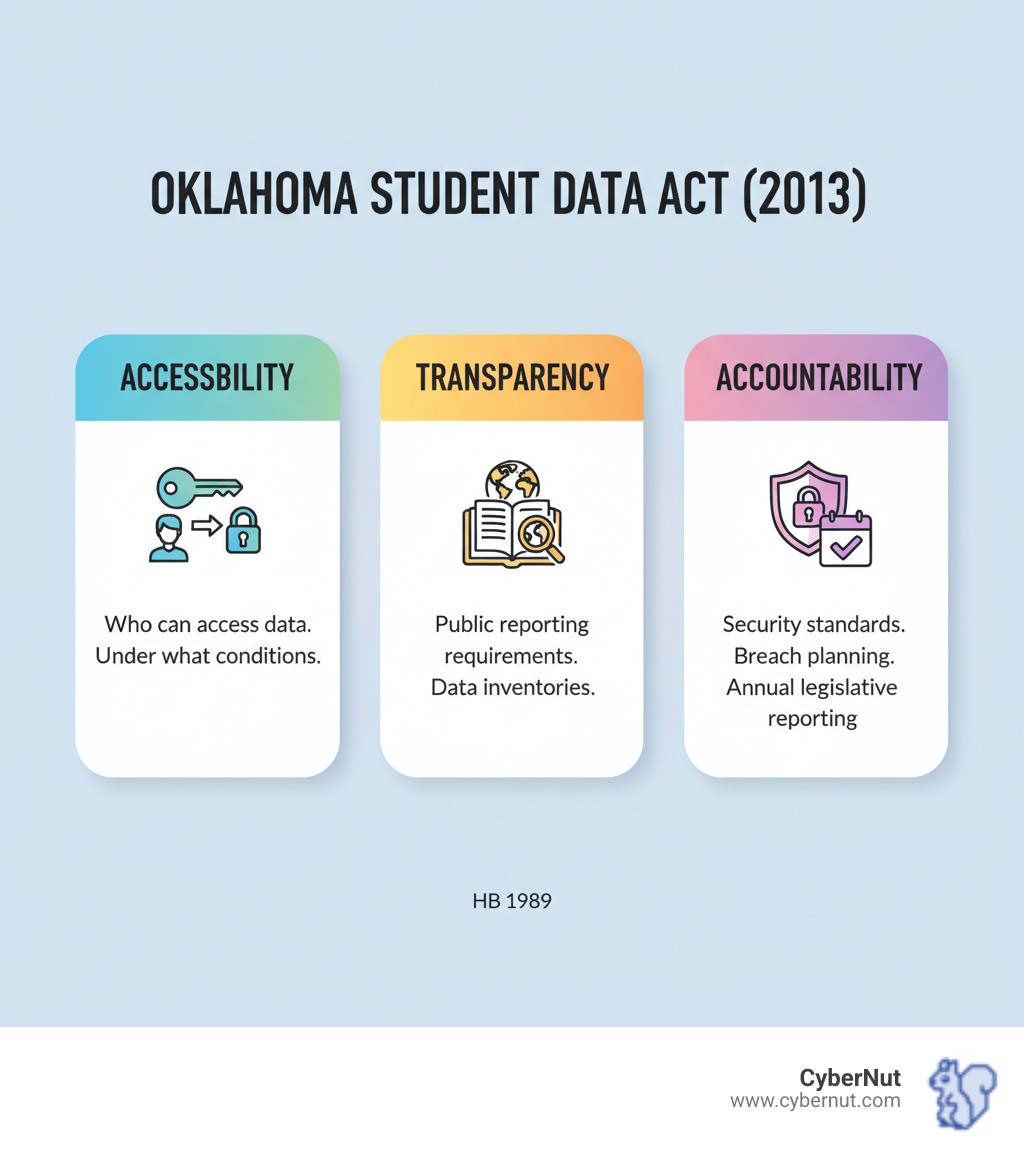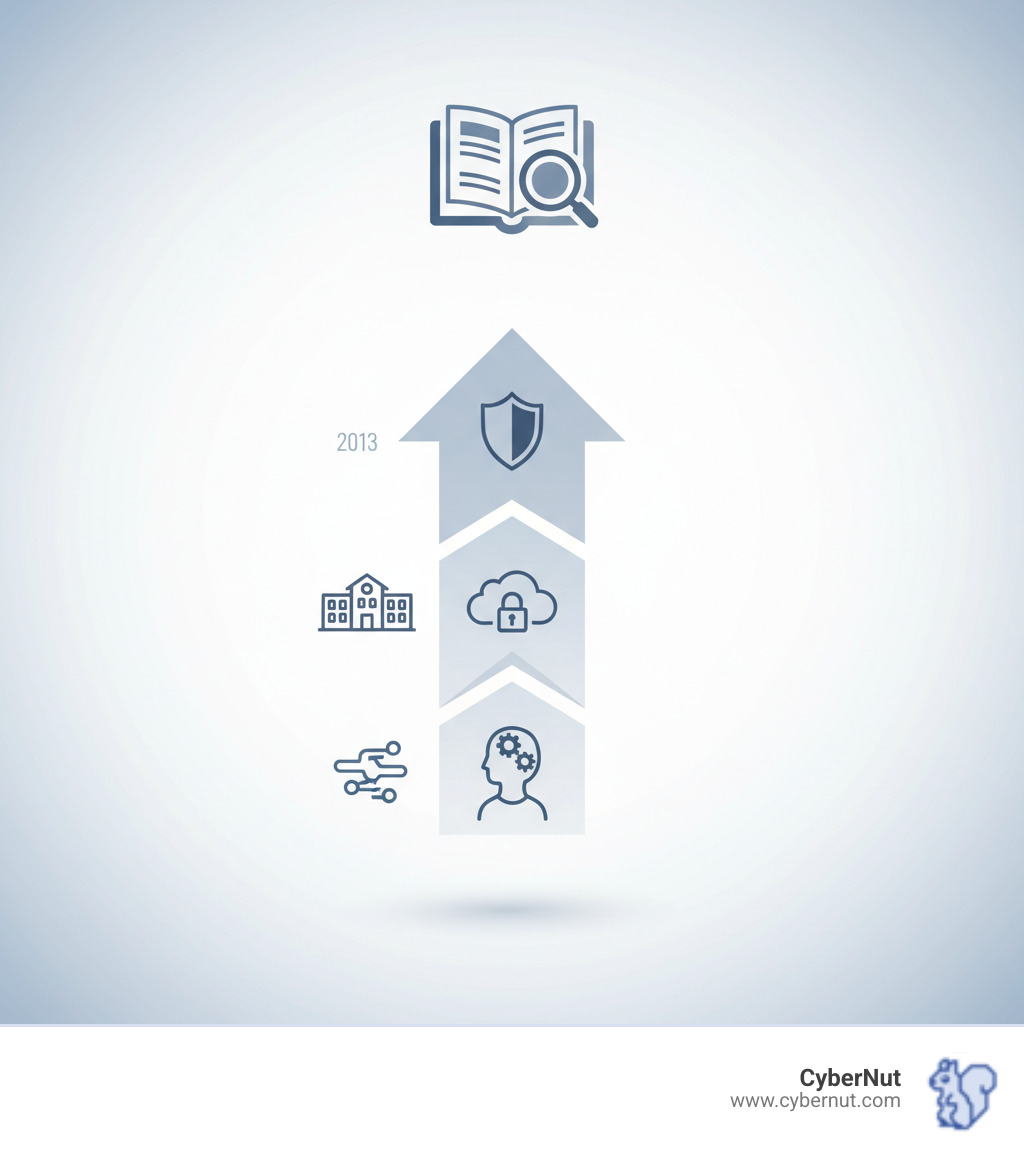
Oliver Page
Case study
October 15, 2025

The Oklahoma Student Data Accessibility, Transparency, and Accountability Act (2013), or HB 1989, is a state law that governs how schools collect, protect, and share student information. It requires the Oklahoma State Board of Education to publicly report what data is collected, create a detailed security plan, and limit who can access individual student records.
Key provisions of the Act include:
This law emerged in 2013 as national student data privacy concerns grew, partly in response to the controversial inBloom project. This $100 million data warehouse would have shared student data with for-profit vendors without parental consent. As parents and advocates voiced concerns, Oklahoma became one of the first states to take decisive legislative action, moving data governance from behind-the-scenes decisions into a public, accountable process.
For K-12 IT Directors, HB 1989 provides clear legal guidelines and specific compliance obligations. Understanding these requirements is the first step toward building a secure data environment that protects the students you serve.

Oklahoma Student Data Accessibility, Transparency, and Accountability Act (2013) basics:
The Oklahoma Student Data Accessibility, Transparency, and Accountability Act (2013), or HB 1989, fundamentally changed how the state protects student information. Before its passage, data handling often lacked public scrutiny, leaving parents with little visibility into how their children's information was used. The Act's intent was to use data to support education while rigorously protecting student privacy through public reporting, clear security standards, and strict access limits.
This law works alongside Oklahoma's Parents' Bill of Rights (HB 1384), which reinforces parental authority, including the right to access school records and opt out of certain data collections. Together, these laws ensure data serves students, not the other way around.
To understand HB 1989, it's important to know the types of data it covers:
The Act protects a wide range of information that constitutes a student's educational record. This includes:
The Act specifically excludes certain highly sensitive information unless it becomes part of an educational record, such as juvenile delinquency records, criminal records, medical records, Social Security numbers, and biometric data.
The primary driver for HB 1989 was the national inBloom controversy in the early 2010s. This project aimed to create a cloud-based data warehouse for student information that could be shared with for-profit vendors, often without parental consent. It exposed significant gaps in federal privacy laws like FERPA and COPPA.
In response to widespread parental outrage and a recognized lack of public oversight in data handling, Oklahoma took action. The Oklahoma Student Data Accessibility, Transparency, and Accountability Act (2013) became one of the first comprehensive state laws to address these concerns head-on, establishing Oklahoma's pioneering role in student data privacy and setting a model for other states.
The Oklahoma Student Data Accessibility, Transparency, and Accountability Act (2013) establishes a comprehensive framework for data governance and security. It recognizes that sensitive student information is vulnerable and mandates strict security measures and clear rules about who can access it. This framework covers technical safeguards, administrative controls, and vendor oversight, requiring any third-party company handling student data to meet rigorous privacy and security standards.

The Act strictly limits access to individual student data within the State Department of Education's system. Access is restricted to:
Crucially, the Act restricts out-of-state data transfers. While generally prohibited, transfers are permitted for specific reasons, such as when a student transfers to an out-of-state school, for federal program requirements, or under vendor contracts that include robust privacy and security safeguards.
HB 1989 requires a detailed, written data security plan to protect student information. For K-12 IT Directors, this plan is a cornerstone of compliance and must include:
The Oklahoma Student Data Accessibility, Transparency, and Accountability Act (2013) gives the Oklahoma State Board of Education central oversight responsibility. The Board acts as the guardian of student data, ensuring that management practices are transparent and accountable to the public.

The Act assigns the State Board of Education several critical duties:
HB 1989 uses concrete mechanisms to ensure public oversight. The requirement for public access to data policies demystifies the rules governing student information, allowing parents, educators, and advocates to understand and verify protections.
A practical example is the Oklahoma School Report Cards, which use aggregated data to provide public insight into school performance while protecting individual student privacy. The State Department of Education's Office of Accountability also handles open records requests and works with school administrators to ensure data accuracy, reinforcing that transparency is only meaningful if the data is reliable. These measures transform student data management from a closed process into a publicly accountable one.
The Oklahoma Student Data Accessibility, Transparency, and Accountability Act (2013) was part of a national wave of state-level action on student privacy. Between 2014 and 2018, states passed nearly 100 new student privacy laws, responding to concerns that federal laws were not keeping pace with technology. Organizations like the Data Quality Campaign have tracked this trend, and Oklahoma's HB 1989 was a pioneering effort that influenced other states.
In 2014, Oklahoma further strengthened protections by passing the "Parents' Bill of Rights" (HB 1384). This law gives parents the right to opt out of certain district-level data collection instruments, adding another layer of parental control over their children's information.
HB 1989 does not replace the federal Family Educational Rights and Privacy Act (FERPA); it builds upon it. While FERPA provides a baseline for privacy by giving parents rights to inspect, amend, and control the disclosure of education records, its definitions can be broad. For example, FERPA's allowance for sharing data with "school officials" who have a "legitimate educational interest" can include outside vendors, a flexibility that contributed to the inBloom controversy.
Oklahoma's Act tightens these controls significantly. It goes beyond FERPA by:
FERPA sets the floor for student privacy, while HB 1989 builds a more robust structure on top of it.
The Act has created clear benefits but also ongoing challenges for the Oklahoma education community.
Implementation Challenges: The State Department of Education (SDE) and local districts face the significant task of ensuring ongoing compliance. This requires substantial administrative, technical, and financial resources. Resource allocation is a major concern, especially for smaller districts. As threats like sophisticated phishing attacks evolve, continuous investment in technology and training is critical. A well-trained staff is a school's first line of defense, and assessing your current risk with a phishing audit is a proactive step toward better security.
Navigating student data privacy laws can be complex. Here are concise answers to common questions about the Oklahoma Student Data Accessibility, Transparency, and Accountability Act (2013).
The Act was created in response to growing national concerns about student data privacy, exemplified by the inBloom controversy. Before HB 1989, data handling in Oklahoma lacked public oversight. The law's main purpose was to create a transparent and accountable process for managing student data, ensuring it is used to support learning while being protected from misuse and commercial exploitation.
Yes. In conjunction with Oklahoma's "Parents' Bill of Rights" (HB 1384), parents can opt their children out of certain data collection instruments at the district level. However, this right does not apply to data considered necessary and essential for creating a student's official public school record, such as grades, attendance, and transcripts. This balances parental control with the school's need to maintain core educational records.
Transparency is a core pillar of the Act. The State Board of Education's main transparency duties are:
These requirements ensure that the management of student data is an open process, building public trust. If you're looking to strengthen your school's overall cybersecurity posture, consider a phishing audit for your school to identify and address key vulnerabilities.
The Oklahoma Student Data Accessibility, Transparency, and Accountability Act (2013) is a landmark law that has fundamentally shaped how the state protects student information. By passing HB 1989, Oklahoma established a clear framework built on transparency, accountability, and security. It gave parents the right to know what data is collected, mandated that the State Board of Education operate openly, and set firm boundaries on who can access student records.
For educators and IT directors, the Act provides invaluable clarity on data handling responsibilities. However, compliance is not a one-time task. The digital landscape is constantly evolving, and so are the threats targeting schools. Cybersecurity requires ongoing vigilance, especially against sophisticated phishing attacks that remain a primary vector for data breaches.
Technology alone cannot protect student data. A well-trained, security-aware staff is the most critical line of defense. Every employee who recognizes a suspicious email or follows proper security protocols helps safeguard sensitive information.
At CyberNut, our mission is to build that human firewall. We provide custom, engaging phishing awareness training designed specifically for the K-12 environment. Our low-touch, gamified approach fits into busy schedules, making cybersecurity training effective without being overwhelming.
The Oklahoma Student Data Accessibility, Transparency, and Accountability Act (2013) provided the legal foundation. Now, it is up to all of us to build a culture of security that brings that foundation to life in every school.
Is your school prepared for today's cyber threats?
Get a Phishing Audit for your school and find where your vulnerabilities lie before they can be exploited.
Want to strengthen your cybersecurity knowledge?
Explore Cybersecurity Resources from CyberNut, designed specifically for educational institutions like yours.

Oliver Page

Some more Insigths


Back